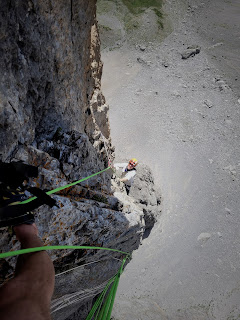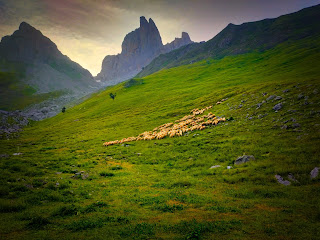The extreme warm weather of May and June has been relentless, and for Friday, forty degrees was forecasted for Toulouse with even warmer temperatures further west. Thus me and Alex went to the High Pyrenees for some colder temps, even though the meteorologists talked about temperatures of above 30 even above the tree line.
 |
| Approaching in early morning. Already well above 20 degrees at 1800 masl! |
 |
| Petit Aiguille d'Ansabère. Spigolo is the obvious spur on the left |
One of the classics in the Pyrenees that J. has done before we met is Spigolo on the impressive pillar Petit Aiguille d'Ansabère, as such I was happy to find someone else to climb it with.
 |
| L2 5c R. Not perfect rock, some funky gear |
Spigolo is Italian for ‘spur’, and I guess that the first ascensionist, Raymond Despiau, was inspired by the similarities in look to the spurs of the Dolomites. Something else that he was clearly inspired by was the alpine methods to murder the impossible by bolting aid-ladders whenever the rock got too blank for their free-climbing abilities. Amazingly enough lots of the rivets put in place in 1967 are still there and are still used for direct aid by most parties on the route. Some of the pitons used for protection also likely dates from the late 60s, by the look of them.
 |
| L3 6c. Three pitons according to the topo. One of them is still there. |
The route was freed by Serge Casteran in 1984, at 7a and 7b for the two hardest pitches. Mr. Casteran was— and still is to this day—a complete master of free climbing, but I strongly suspect that there are more than one hold missing from that ascent thirty years ago. To be fair, it was warm on the wall, with temperatures well above 25 degrees, but neither me nor Alex freed L5 or L6 — neither on lead nor following. I also got really tired from trying to link L6 were I had a hang on the rope somewhere in the middle. Normally, both of us should be OK on vertical 7bs...
 |
| L5, 7a+. Or so. Bolts everywhere for the convenience of the A0 climber |
Nowadays there are all type of fixed equipment on the route. Some old rivets from the 60s, 8 mm expansion bolts which look like they are from the early 80s, 10 mm and even 12 mm bolts from more recent times, and lots of pitons of various type and age — there is even an old wooden piton threaded with a fairly new sling!
 |
| L9 6a+. The rock starts to be good! |
 |
| L10 6c. "Wendenstöcke-like quality rock" |
Gear: a set of wires from small to medium and a set of cams from micro to camalot #1 (red). The smallest we placed was a black totem (#0.5 11.7 mm at its minimum range). The red camalot was likely superfluous. Twelve draws including five 60 cm draws (perhaps more if you want to link pitches) and a double shoulder length sling, plus something for the belays. We climbed on a single 60m rope and had a haul-rope/zip line.
Hauling is fine. We climbed L1, L2 and L10 with a bag which we hauled on all other pitches; this worked well. Due to the extremely high temperatures we hauled 7 litres of water!
Approach: Walk in to the cabins of Ansabère from the parking at Pont Lamary(1 hour), then take the path leading up to the Col de Pétragème and scramble up to the base of the spur (about 1 hour more). There is drinking water at the cabins.
L0 2a 10m. Scramble up and right some 10-15m to the top of a small detached pillar and rope up and belay from a single bolt.
L1 4c 35m. Easy climbing, but pay attention to finding the most solid rock. The first bolt after some 10 m. Do not stop at the first belay (3 old bolts) but keep going another 5 m to a second belay with some slightly newer bolts. Two bolts and a few pieces of gear.
L2 5b R 55m. Hike up ledges up to a steeper pillar and find the first bolt some 5m to the right of the left edge of the pillar. Then some pitons and some questionable gear on decidedly average rock leads to a good belay on new bolts on a comfortable ledge below a short steep dihedral on the left side of the arete.
L3 6c 20m. A steep dihedral. One bolt at the start, then some micro friends and an old piton to easier climbing. Only two pieces on fixed protection on this pitch. Good semi-hanging belay on bolts.
L4 6b 25m. Some fixed protection, but mostly on gear. Belay on bolts.
L5 7a+ 18m. Well hard and bolted as an A0 ladder for aid-climbers so there are bolts everywhere but not always in the best place for a free ascent. No gear needed.
L6 7b? 20m. Very hard, see above for the bolting. Bolts a little bit further apart and there are some obligatory 6c moves if free climbing, so climbers who are in well above their head should probably bring hooks. This is might actually be the reason why this pitch felt so hard, as I can imagine that it is pretty easy to break holds with hooks as the rock is pretty friable. No gear needed.
L7 6a+ 15m. A short traverse leftwards. Three bolts. No need for any gear. Excellent rock.
L8 6b+? 35m. Runout on questionable fixed gear with very few opportunities to supplement with friends/wires. The hardest parts are well protected by brand new bolts, but I doubt the mandatory grade is below 6b+ unless you bring hooks. Excellent rock. We found this very hard for the grade.
L9 6c 30m. The original route goes out left (at 6b), the direct version goes right on really good rock. Brilliant climbing past many bolts to a finish on a traverse out right on pitons. No friends/wires.
L10 5c R 30m. Two bolts and no gear. The first bolt is some 10 m up and slightly to the right of the belay (above the bulge and well above the difficulties of the pitch). Go left around the small corner then back up right to very easy climbing on solid rock. (Note: The route Borrokan Aske comes up from the right, and it is possible to traverse into this (7a+) after the first bolt).
Descent: Rap from the top down the other side. First rap is 29m, second rap 28m. Then go a few meter straight out from the wall before starting to scramble down and skiers left to the saddle (very airy). Keep traversing past some cairns until you reach a red couloir with loose rock. This is where we went wrong, apparently ‘you arrive at the base of an easy couloir that allows you to return to the plateau behind the Petit Pic d'Ansabère, then descend the grassy slopes of the Petit Pic d'Ansabère towards the south to reach the Col de Pétragème before walking back to the Cabane d'Ansabère’. (Description within quotation marks is translated from here.)
 |
| Across the brèche/saddle. So far so good.... |
We walked down the scree forever until it is possible to traverse skiers right back towards the pillar. This took us around 4 hours and felt pretty serious at times.
 |
| Sheep herding at altitude with Petit Aiguille d'Ansabère in the background |











